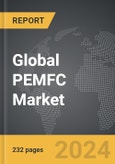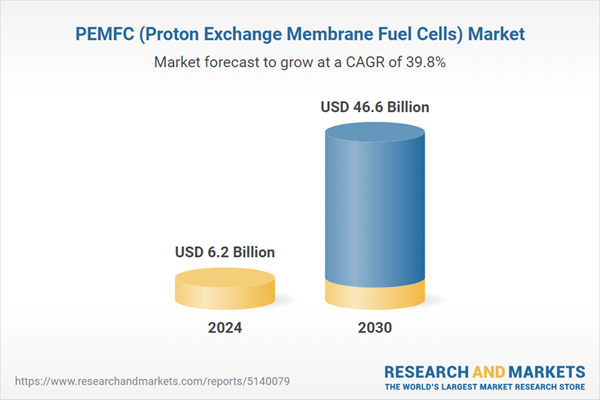The global market for PEMFC (Proton Exchange Membrane Fuel Cells) was valued at USD 6.2 Billion in 2024 and is projected to reach USD 46.6 Billion by 2030, growing at a CAGR of 39.8% from 2024 to 2030. This comprehensive report provides an in-depth analysis of market trends, drivers, and forecasts, helping you make informed business decisions.
Global Proton Exchange Membrane Fuel Cells (PEMFC) Market - Key Trends & Drivers Summarized
How Are Technological Advancements Transforming the PEMFC Industry?
The Proton Exchange Membrane Fuel Cell (PEMFC) market has experienced rapid growth, largely driven by technological advancements that have made these cells more efficient, durable, and adaptable across various sectors. PEMFCs generate electricity through the electrochemical reaction between hydrogen and oxygen, producing only water as a byproduct, making them a clean energy solution. Recent innovations in membrane materials, catalyst development, and stack design have enhanced the overall performance of PEMFCs, making them more reliable for both stationary and mobile applications. The use of platinum as a catalyst, which initially raised concerns over cost, is being optimized through the development of platinum alloy catalysts and alternative materials that reduce the overall platinum loading without sacrificing efficiency. Additionally, improvements in membrane durability and proton conductivity are helping to extend the operational life of PEMFCs, making them more viable for long-term use in industries like transportation and backup power generation. These advancements are pushing the boundaries of PEMFC applications, making them an increasingly attractive option in the transition to a low-carbon energy system.Why Are PEMFCs Gaining Traction in the Transportation Sector?
The transportation sector has emerged as a significant area of growth for PEMFC technology, particularly in applications related to hydrogen-powered vehicles. Fuel cell electric vehicles (FCEVs), which use PEMFCs to convert hydrogen into electricity, are seen as a promising solution to reduce emissions in the automotive industry. Unlike battery electric vehicles (BEVs), FCEVs can be refueled quickly - typically in under five minutes - making them more suitable for long-range travel and heavy-duty transportation like buses, trucks, and trains. In this context, PEMFCs offer a clear advantage due to their high energy density and ability to provide consistent power over extended periods. Major automotive manufacturers, including Toyota, Hyundai, and Honda, have invested heavily in the development of FCEVs, further driving demand for PEMFC technology. Additionally, governments worldwide are offering incentives and funding for hydrogen infrastructure development, particularly in regions such as Europe, Japan, and South Korea, where hydrogen is seen as a key component of future transportation strategies. As the demand for clean mobility solutions grows, PEMFCs are becoming an integral part of the decarbonization strategy for the transportation industry.How Are Energy and Industrial Sectors Adopting PEMFC Technology?
Beyond transportation, the adoption of PEMFC technology is expanding in the energy and industrial sectors, where these fuel cells are being used for backup power, distributed generation, and off-grid applications. PEMFCs provide reliable, efficient, and scalable power solutions, making them ideal for industries that require uninterrupted power supply, such as data centers, hospitals, and telecommunication networks. In addition, the flexibility of PEMFCs to be used in conjunction with renewable energy sources like wind and solar has made them a popular choice for grid stabilization and energy storage solutions. PEMFCs are also gaining traction in the industrial sector, particularly in materials handling equipment such as forklifts, where they offer longer operational hours compared to traditional battery systems. The growing interest in hydrogen as a clean fuel is encouraging more industries to explore PEMFCs as part of their energy transition strategies. Companies are increasingly investing in PEMFC technology to enhance energy security and reduce their carbon footprint, aligning with global sustainability goals and regulatory pressures to limit greenhouse gas emissions.What Are the Key Drivers of Growth in the PEMFC Market?
The growth in the Proton Exchange Membrane Fuel Cells (PEMFC) market is driven by several factors, including technological advancements, increasing adoption in transportation and energy sectors, and supportive government policies. One of the main drivers is the rising demand for clean energy solutions to combat climate change, which has led to increased investment in hydrogen-based technologies, including PEMFCs. The transportation sector, particularly the development of fuel cell electric vehicles (FCEVs), is a significant growth area, with major automotive manufacturers and governments investing in hydrogen infrastructure and production capabilities. Additionally, PEMFCs' potential to provide efficient and reliable power for industrial applications, off-grid energy systems, and backup power solutions is driving wider adoption. Technological improvements, such as advancements in catalyst efficiency and membrane durability, are also enhancing the commercial viability of PEMFCs by reducing costs and extending the lifespan of fuel cells. Moreover, regulatory frameworks that promote the use of hydrogen and fuel cell technologies, along with subsidies and incentives for clean energy projects, are further accelerating market growth. As the global push for decarbonization intensifies, PEMFCs are emerging as a key player in the future of clean energy.Report Scope
The report analyzes the PEMFC (Proton Exchange Membrane Fuel Cells) market, presented in terms of market value (USD Thousand). The analysis covers the key segments and geographic regions outlined below.Segments
Application (Transport, Stationary, Other Applications).Geographic Regions/Countries
World; United States; Canada; Japan; China; Europe (France; Germany; Italy; United Kingdom; and Rest of Europe); Asia-Pacific; Rest of World.Key Insights:
- Market Growth: Understand the significant growth trajectory of the Transport Application segment, which is expected to reach $38.5 Billion by 2030 with a CAGR of a 41.5%. The Stationary Application segment is also set to grow at 34.2% CAGR over the analysis period.
- Regional Analysis: Gain insights into the U.S. market, valued at $1.8 Billion in 2024, and China, forecasted to grow at an impressive 37.6% CAGR to reach $6.6 Billion by 2030. Discover growth trends in other key regions, including Japan, Canada, Germany, and the Asia-Pacific.
Report Features:
- Comprehensive Market Data: Independent analysis of annual sales and market forecasts in USD from 2024 to 2030.
- In-Depth Regional Analysis: Detailed insights into key markets, including the U.S., China, Japan, Canada, Europe, Asia-Pacific, Latin America, Middle East, and Africa.
- Company Profiles: Coverage of major players such as Altergy Systems, Ballard Power Systems, Inc., FKK Corporation, FuelCell Energy, Inc., Horizon Fuel Cell Technologies Pte Ltd. and more.
- Complimentary Updates: Receive free report updates for one year to keep you informed of the latest market developments.
Why You Should Buy This Report:
- Detailed Market Analysis: Access a thorough analysis of the Global PEMFC (Proton Exchange Membrane Fuel Cells) Market, covering all major geographic regions and market segments.
- Competitive Insights: Get an overview of the competitive landscape, including the market presence of major players across different geographies.
- Future Trends and Drivers: Understand the key trends and drivers shaping the future of the Global PEMFC (Proton Exchange Membrane Fuel Cells) Market.
- Actionable Insights: Benefit from actionable insights that can help you identify new revenue opportunities and make strategic business decisions.
Key Questions Answered:
- How is the Global PEMFC (Proton Exchange Membrane Fuel Cells) Market expected to evolve by 2030?
- What are the main drivers and restraints affecting the market?
- Which market segments will grow the most over the forecast period?
- How will market shares for different regions and segments change by 2030?
- Who are the leading players in the market, and what are their prospects?
Some of the 18 major companies featured in this PEMFC (Proton Exchange Membrane Fuel Cells) market report include:
- Altergy Systems
- Ballard Power Systems, Inc.
- FKK Corporation
- FuelCell Energy, Inc.
- Horizon Fuel Cell Technologies Pte Ltd.
- Hydrogenics Corporation
- Johnson Matthey Fuel Cells
- Nedstack Fuel Cell Technology BV
- Nuvera Fuel Cells LLC
- Oorja Corporation
- Plug Power Inc.
- Protonex Technology Corporation
- RELiON Battery, LLC
- SerEnergy A/S
- Shanghai EverPower Technologies., Ltd.
- Toho Gas Co., Ltd.
Table of Contents
I. METHODOLOGYII. EXECUTIVE SUMMARY2. FOCUS ON SELECT PLAYERSIII. MARKET ANALYSISIV. COMPETITION
1. MARKET OVERVIEW
3. MARKET TRENDS & DRIVERS
4. GLOBAL MARKET PERSPECTIVE
UNITED STATES
CANADA
JAPAN
CHINA
EUROPE
FRANCE
GERMANY
ITALY
UNITED KINGDOM
REST OF EUROPE
ASIA-PACIFIC
REST OF WORLD
Companies Mentioned (Partial List)
A selection of companies mentioned in this report includes, but is not limited to:
- Altergy Systems
- Ballard Power Systems, Inc.
- FKK Corporation
- FuelCell Energy, Inc.
- Horizon Fuel Cell Technologies Pte Ltd.
- Hydrogenics Corporation
- Johnson Matthey Fuel Cells
- Nedstack Fuel Cell Technology BV
- Nuvera Fuel Cells LLC
- Oorja Corporation
- Plug Power Inc.
- Protonex Technology Corporation
- RELiON Battery, LLC
- SerEnergy A/S
- Shanghai EverPower Technologies., Ltd.
- Toho Gas Co., Ltd.
Table Information
| Report Attribute | Details |
|---|---|
| No. of Pages | 232 |
| Published | April 2025 |
| Forecast Period | 2024 - 2030 |
| Estimated Market Value ( USD | $ 6.2 Billion |
| Forecasted Market Value ( USD | $ 46.6 Billion |
| Compound Annual Growth Rate | 39.8% |
| Regions Covered | Global |









